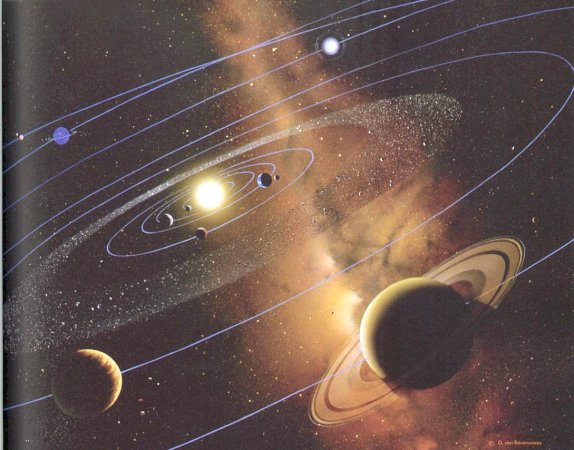
Sun As Stars
Stars look like tiny bright specks in the night sky.But they are not tiny at all.
They in fact huge balls of searing hot gas.Stars look small only because they lie
many million kilometers away.If you could get close to a star,you would find that
it looked like our Sun,because the sun is a star too.

Parts Of The Sun
Prominence
Prominence is a large bright feature extending outwards from the sun's surface, often in a loop configuration. Prominences are anchored to the solar surface in the photosphere, and extend outwards into the solar corona. While the corona consists of extremely hot ionized gases, known as plasma, which do not emit much visible light, prominences contain much cooler plasma, similar in composition to that of the chromosphere.Read More
Visit Wikipedia Convective Zone
The convection zone is the outermost layer of the Sun's interior. Energy is transferred there in convection currents, rather than energetic photons. Once hot gas convects up to the photosphere, it emits photons into space, cools, and settles back into the Sun. This convective flow is the origin of solar granules, and the departing energy is the visible light and other electromagnetic radiation that the Sun emits into space. (A good example of convection current is a lava lamp.)Read More
Visit Wikipedia Radiative Zone
Radiation is a very important aspect of the Sun. It is the main process through which the Sun transfers its energy out into space. The radiative zone of the solar interior is characterized by the process of radiation.
The energy made in the core is in the form of photons, more specifically in gamma rays, when it first begins its journey outward. This energy is changed into less energetic photons as it moves through the radiative zone. This is good for us because gamma rays are very dangerous to humans!Read More
Visit Solar-Heliospheric Core
The core of the Sun is considered to extend from the center to about 0.2 solar radius. It is one of the hottest things in the universe. It has a density of up to 150,000 kg/m3 (150 times the density of water on Earth) and a temperature of close to 15,000,000 Kelvins (by contrast, the surface of the Sun is close to 6,000 Kelvins). Energy is produced by exothermic thermonuclear reactions (nuclear fusion) that mainly convert hydrogen into helium. The core is the only location in the Sun that produces an appreciable amount of heat via fusion: the rest of the star is heated by energy that is transferred outward from the core. All of the energy produced by fusion in the core must travel through many successive layers to the solar photosphere before it escapes into space as sunlight or kinetic energy of particles.Read More
Visit Wikipedia Sunspots
A sunspot is a region on the Sun's surface (photosphere) that is marked by a lower temperature than its surroundings and has intense magnetic activity, which inhibits convection, forming areas of low surface temperature. Although they are blindingly bright at temperatures of roughly 4000-4500 K, the contrast with the surrounding material at about 5800 K leaves them clearly visible as dark spots. If they were isolated from the surrounding photosphere they would be brighter than an electric arc. As of 2006, we are near the minimum (predicted for 2007) in the sunspot cycle [1]. Sunspots are often related to intense magnetic activity such as coronal loops and reconnection.Similar phenomena observed on stars other than the Sun are commonly called starspots.Read More
Visit Wikipedia Photosphere
The photosphere of an astronomical object is the region at which the optical depth becomes 2/3 for a photon of wavelength equal to 500 nanometers. In other words, the photosphere is the region where an object stops being transparent to ordinary light. Because stars are believed to have no solid surface, the photosphere is typically used to describe the Sun or another star's visual surface. The term itself is derived from Ancient Greek roots, φοτος/photos meaning "light" and σφαιρος/sphairos meaning "ball", in reference to the fact that it is a ball-shaped surface perceived to emit light.Read More
Visit Wikipedia Coronal Hole
Coronal holes are areas where the Sun's corona is darker, colder, and has lower-density plasma than average. These were found when X-ray telescopes in the Skylab mission were flown above the earth's atmosphere to reveal the structure of the corona. Coronal holes are linked to unipolar concentrations of open magnetic field lines. During solar minimum, coronal holes are mainly found at the Sun's polar regions, but they can be located anywhere on the sun during solar maximum. The fast-moving component of the solar wind is known to travel along open magnetic field lines that pass through coronal holes.Read More
Visit Wikipedia Chromosphere
The chromosphere (literally, "color sphere") is a thin layer of the Sun's atmosphere just above the photosphere, roughly 10,000 kilometers deep (approximating to, if a little less than, the diameter of the Earth). The chromosphere is more visually transparent than the photosphere. The name comes from the fact that it has a reddish color, as the visual spectrum of the chromosphere is dominated by the deep red H-alpha spectral line of hydrogen. The coloration may be seen directly with the naked eye only during a total solar eclipse, where the chromosphere is briefly visible as a flash of color just as the visible edge of the photosphere disappears behind the Moon.
Without special equipment the chromosphere cannot normally be seen due to its being washed out by the overwhelming brightness of the photosphere. It can be seen clearly through special narrow-band optical filters tuned to the H-alpha spectral line, and many observatories routinely observe the chromosphere using this technique, which displays filaments quite clearly. Filaments (and prominences, which are filaments viewed from the side) are the source of many coronal mass ejections and hence are important to prediction of space weather.Read More
Visit Wikipedia Corona
A corona is a type of plasma "atmosphere" of the Sun or other celestial body, extending millions of kilometres into space, most easily seen during a total solar eclipse, but also observable in a coronagraph.
French 1999 eclipse
French 1999 eclipse
The high temperature of the corona gives it unusual spectral features, which led some to suggest, in the 19th century, that it contained a previously unknown element, "coronium"; however these spectral features have since been traced to highly ionized Iron (FeXIV) which indicates a plasma temperature in excess of 10.Read More
Visit Wikipedia Flare
A solar flare is a violent explosion in the Sun's atmosphere with an energy equivalent to a billion megatons, traveling normally at about 1 million km per hour (about 0.05% the speed of light), though sometimes much faster. The flares have been known to affect the electro transmission of many earthly communication devices including computers, cell phones, pagers and automobiles. Solar flares take place in the solar corona and chromosphere, heating plasma to tens of millions of kelvins and accelerating the resulting electrons, protons and heavier ions to near the speed of light.Read More
Visit Wikipedia
A Stars Life Cycle
Do Stars Last Forever?
Just like living things,stars are born
grow older and in time,die.The diagram above show two different
ways in which stars die.After shining steadily for some times the
giants shrink into a white,then a black dwarf.This will happen to
the Sun one day.Other stars swell up from a red giant to a super
giant before exploding as a supernova.
How Hot Are Stars?
Stars are great globes of very hot gas,but their temperature
varies quite a lot.Astronomers can tell the temperature of a star
by the colour and brightness of the light it gives out.Yellowish
stars like the sun have a temperature of about 5,500 degree celcius.
This compares with about 3,000 degree celcius for a dim red star to
30,000 degree celcius for a bright blue-white star.
Why Do Some Stars Explode?
Massive stars explode when they come to the end of their lives.
They swell up into huge supergiants.Supergiants are unstable,so they
collapse and blast themeselves into pieces in an explosion called a
supernova.Supernovae are the biggest explosions in the universe,as
bright as billions of Suns put together.
What Makes Black Holes Black?
After a star explodes as a supernova what is left of it shrinks
rapidly.If it is really big,it shrinks almost to nothing.All that is
left is a tiny region will suck in all nearby matter,including other
stars.The name "Black Hole" comes from the fact that the pull it
exerts so powerful that even light cannot escape from it.

















